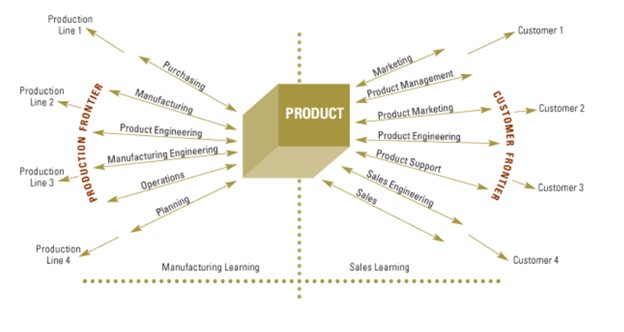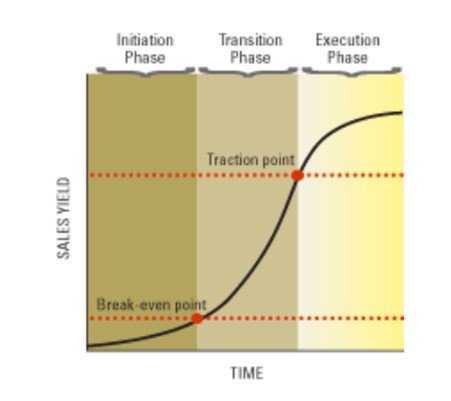Launching a new product requires effort to ensure its success. Once a new product is on the market, companies usually want to push it onto prospects and have these convert into paying customers as soon as possible.
To achieve this feat, organizations are often tempted to either hire new sales reps to cover new ground, overtrain existing sales staff, or have too high expectations from the get-go.
However, these approaches often lead to pitfalls, including mismanagement of financial and employee resources and setting up sales staff for undue stress and possible failure to meet revenue expectations.
Before a company learns to sell a product in the market efficiently, its staff, including those in leadership positions, need to know how customers will obtain the product and its intended use. This process is called the sales learning curve, and it is integral to continuous sales success.
Analogous to the Manufacturing Learning Curve
The sales learning curve is often compared to the manufacturing learning curve.
In this model, product teams and employees collaborating in the purchasing, manufacturing, engineering, planning, and operations departments use their knowledge and experience in their respective fields to improve the production process.
They convey this information to employees in other areas in a give-and-take dynamic to improve and refine the process that extends from product creation to how it is sold.
 (Source: Harvard Business School)
(Source: Harvard Business School)
Defining the Sales Learning Curve
In principle, the Sales Learning Curve is a learning process similar to the one used in the manufacturing industry.
It unfolds in much the same way – product support and product development use their knowledge and experience about the product in question to educate marketing, sales, and customer success teams about it.
This company-wide expertise on the product is then used to educate and nurture customers across the buyer's journey. As customers purchase the product and use it, the organization can modify its offering(s) and market and sell it to fit the customer's needs.
As sales yields increase, the learning process extends into three different phases:
- Initiation
- Transition
- Execution
Each phase will require a different sales approach and sales force to focus on selling its products.
As the company continues to sell a product, it learns which marketing and sales strategies are required to produce better results. The focus should also be on the best way to allocate company resources so that team members can set and achieve manageable sales expectations and avoid cash shortfalls.
An effective sales learning curve can provide a plan to reduce the time and money required to close deals and generate revenue.
Stages of the Sales Learning Curve
The sales learning curve tracks your team's sales yields over time. As sales leadership traces the progress made, sales can adjust its strategy to bridge the gap between sales objectives and revenue.
As the sales team implements and tests varying strategies, the sales learning process continues to unfold through different stages. Sales will transition from one stage to the next insofar as it reaches the break-even point, which happens when the total cost and total revenue are equal, and the traction point, which takes place as revenue increases and the business grows.
 (Source: Harvard Business School)
(Source: Harvard Business School)
Phase 1: Initiation
The initiation stage starts when the product is fully developed and ready to be sold in its market. As with most new products, few customers are likely willing to purchase it.
Required skills: Within an organization, product development, marketing, sales, and customer success will need to learn through prior experience and trial and error which strategies work to entice potential customers to purchase it.
Scott Hasting, the co-founder of BetWorthy, shares how his company has pursued this particular goal.
"The sales learning curve is still a novel concept for many business owners who are following the traditional high volume aggressive sales model. The curve mentality requires collaboration and engagement of all levels of product development, sales, and marketing. Rather than pushing our product out to unwilling customers, we decided to generate leads and interest first before incorporating our sales rep's feedback into the new product itself.
Our company's second focus is on peer learning and team-based effort when generating leads and closing deals. Rather than creating a cut-throat competition and pitting the reps against each other, we emphasize combined targets, and employees are incentivized based on these. Since this change, our sales yield has seen quite a boost."
At this stage, the focus should be on learning.
Sales team members would do best to learn as much about the product as possible, including its benefits and how customers are meant to use it.
With an understanding of the product, sales reps can contribute the insight they gain from interacting with potential customers and help their colleagues in marketing and engineering build a better go-to marketing strategy that can yield more sales down the line.
Sales team members must communicate with other parts of their organization openly and have prior experience creating sales models from ambiguous and incomplete information.
Sales costs: During this stage, sales costs are best kept down as team members are focused on learning about the product.
Size of the sales team: While this phase focuses on minimalizing costs, there still needs to be a small sales team to initiate this process and teach new additions down the line.
Phase 2: Transition
To shift into the transition stage, a product should have a significant number of customers, and the number of deals closed should be steadily increasing over time.
As sales grow, sales yields should, too. There should be a point where sales yields can fully cover the expenses (including annual salary plus benefits, onboarding and training costs, among other things) a company invests into each of its sales representatives.
The transition phase will remain in effect until management determines that the product has earned genuine traction in its market.
Required skills: To gain traction, sales management should mature a proven sales model that repeatedly produces results. Other aspects include improving the product's positioning in the market and recruiting qualified sales reps.
Since the sales learning curve is still in effect, a focus on learning and openly communicating within the organization should be emphasized.
Sales costs: As the product continues to sell, sales costs will naturally increase as new sales staff is hired.
Size of the sales team: At this stage, sales teams should be hiring new sales representatives to help generate more traction. New hires will need to have the skills to collaborate to build an evolving sales process.
Phase 3: Execution
In the execution stage, sales management has sufficient evidence of traction. The sales learning curve, as a learning process, is at its end.
Sales staff has built a proven sales method that generates results and has the infrastructure required to continue fulfilling their responsibilities.
Required skills: Sales representatives need to follow the sales process that has been put in place. If there are areas for improvement, strategies can be tried and proven to boost results.
Sales costs: Sales costs are likely to increase as more staff is added.
Size of the sales team: Organizations should be hiring more sales representatives that can adopt the system already in place.
What the Sales Learning Curve is not
The sales learning curve describes the learning process by which an organization learns the processes that work and do not work.
However, it does not describe the individual learning curve that all marketing, sales, and product customer-facing team members undergo to learn their company responsibilities and functions.
What organizations should learn
Every company experiences a learning process in each of its different departments. Sales, marketing, customer support/success, operations, and product development work individually to fulfill their unique responsibilities.
They also cooperate to ensure that their product's positioning aligns in every aspect of its development and go-to-market strategy.
As a product is developed and marketed to its target audience, it is essential to understand the ideal sales messaging that generates sales yield and traction over time.
The sales learning curve is a prime example of how organizations can try, learn, perfect, and iterate a process that produces results every time.




